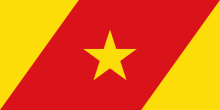Shebel Berenta
Shebel Berenta is one of the woredas in the Amhara Region of Ethiopia, named after two older districts which occupy the area this woreda currently covers: Berenta which is north of the Mecha river, and Shebel which is south of that stream. Part of the Misraq Gojjam Zone, Shebel Berenta is bordered on the southwest by Dejen, on the northwest by Enemay, on the north by Enarj Enawga, and on the east by the Abay River which separates it from the Oromia Region. The major town in Shebel Berenta is Yed Wuha.
Shebel Berenta | |
|---|---|
Woreda | |
 Flag | |
| Zone | Misraq Gojjam |
| Region | Amhara Region |
| Area | |
| • Total | 898.37 km2 (346.86 sq mi) |
| Population (2012 est.) | |
| • Total | 112,619 |
In 2002, Shebel Berenta was judged to be one of four chronically food insecure woredas in this part of the Amhara Region, due to much of their farmland being "extremely depleted, deforested and eroded".[2]
Demographics
Based on the 2007 national census conducted by the Central Statistical Agency of Ethiopia (CSA), this woreda has a total population of 103,988, an increase of 35.39% over the 1994 census, of whom 50,938 are men and 53,050 women; 4,230 or 4.07% are urban inhabitants. With an area of 898.37 square kilometers, Shebel Berenta has a population density of 115.75, which is less than the Zone average of 153.8 persons per square kilometer. A total of 24,584 households were counted in this woreda, resulting in an average of 4.23 persons to a household, and 23,942 housing units. The majority of the inhabitants practiced Ethiopian Orthodox Christianity, with 94.86% reporting that as their religion, while 5.07% of the population said they were Muslim.[3]
The 1994 national census reported a total population for this woreda of 76,807 in 17,407 households, of whom 37,761 were men and 39,046 were women; 1,668 or 2.17% of its population were urban dwellers. The largest ethnic group reported in Shebel Berenta was the Amhara (99.93%).[4] This is a considerable difference from when C.T. Beke passed through the district in November 1841, when he found the inhabitants were "Mietta Gallas, nominally subject to the ruler of Gojam, whose hold on them would, however, appear to be not very strong."[5] The majority of the inhabitants practiced Ethiopian Orthodox Christianity, with 93.82% reporting that as their religion, while 6.1% were Muslim.[4]
Notes
- Geohive: Ethiopia Archived 2012-08-05 at the Wayback Machine
- Hugo Rämi, "Fewer surpluses in Gojam and Awi and Severe shortages in lowland areas of Abaye River Gorge", UN-OCHA Assessment Mission, October 2002 (accessed 23 April 2009)
- Census 2007 Tables: Amhara Region, Tables 2.1, 2.4, 2.5, 3.1, 3.2 and 3.4.
- 1994 Population and Housing Census of Ethiopia: Results for Amhara Region, Vol. 1, part 1, Tables 2.1, 2.7, 2.10, 2.17, Annex II.2 (accessed 9 April 2009)
- Beke, "Route from Ankober to Dima", Journal of the Royal Geographical Society, 12 (1842), p. 256